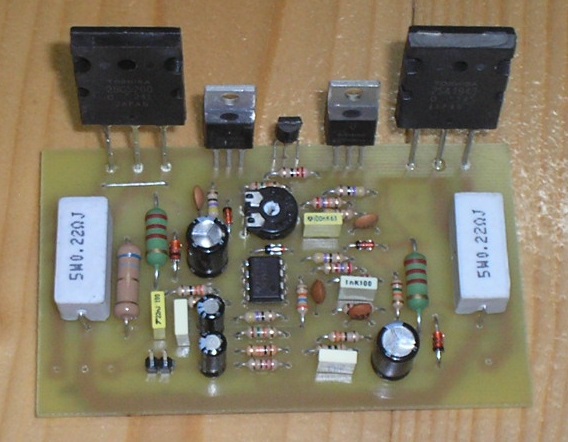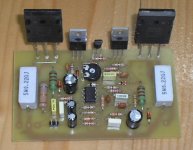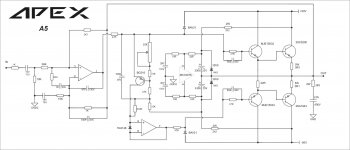zobel should not be getting warm if everything is ok, i feel. i never had that problem with any of my amp builds, some even have 0.5w resistor.I am playing pretty loud right now and those emitter resistors are not even warm. So I think it's OK. I have 5W 0.22R rectangular cement ones but was saving them for another project. The big 2W Zobel resistor is warmer.
Listening impressions:
Very clean neutral amp with wide soundstage and excellent spatial imaging. Low distortion clear highs, no sibillance or fatigue. Great all around amp for listening to wide range of music. Bass is quite good - crisp and punchy. Vocals are excellent and very articulate.
Highly recommended amp to build.
ardi79
the tiniest board is sonal FX-8 50x50mm, also Dobrivoje with ALF08NP- it has lower price likewise 2x LatMos.
I listen to mine nearly the last month- i like the very clear vocals and the over all easy to
listen- and if you give a bit more juice to speaker you will be surprised.
Also many AX11 around here with different Output Transistors- TO-3 or BD249/250....so
on.
thanks sir, there are many great amplifier here. im so impressed with ax14. i have been built it. i have listened for about 3 months. i have plan to build another one, may be fx8 or ax 11.
regards
FX8 Bimo mod sounds very nice. According to Jay, it sounds better than AX11, Inverted JFET Circlophone, Jason K VSSA, FH9, VHEX+, MOSFET Quasi, and even Inverted JFET MOSFET Circlophone.
http://www.diyaudio.com/forums/soli...y-simple-quasi-mosfet-amp-14.html#post4808902
I think Apex Audio himself said FX8 was his favorite "simple" amp.
http://www.diyaudio.com/forums/soli...y-simple-quasi-mosfet-amp-14.html#post4808902
I think Apex Audio himself said FX8 was his favorite "simple" amp.
Hi X,
I see some of your builds and wondering if you've moved into amp building
from your speaker building?
Thank you for organizing some of this stuff. It's always good to see
amps in an organized state. I wish I was better at organizing...I'm
very lateral...so everythings in parallel here. Looking good.
I see some of your builds and wondering if you've moved into amp building
from your speaker building?
Thank you for organizing some of this stuff. It's always good to see
amps in an organized state. I wish I was better at organizing...I'm
very lateral...so everythings in parallel here. Looking good.
Hi X,
I see some of your builds and wondering if you've moved into amp building
from your speaker building?
Thank you for organizing some of this stuff. It's always good to see
amps in an organized state. I wish I was better at organizing...I'm
very lateral...so everythings in parallel here. Looking good.
Hi SyncTronX,
Good to hear from you. Have I moved into building amps? LOL 😛
Lets' see, here is my list of amps so far: Dx, ACA, FX8 50mm, FX8 Bimo, JLH headamp, VHEX+, FH9, FH9HV, Inv JFET Circlophone MOSFET, JK VSSA, MOSFET/BJT Quasi, AX11 Bimo Mod, CFH7
On to-do list: allFET Circlotron, M2, extremeA Sriracha edition
Not sure where to go after extremeA - but that will be a slow-take-my-time build.
I am still working speakers, just not as much as I have too many already. Current project is transient perfect 3-way passive XO reference monitor.
Amps are fun and fast to make and very clean - no sawdust to deal with. Sort of good for a person who likes instant gratification. 😀

I love the simplicity! Very nice Apex Audio! Can you show me where schematic is posted so I can add to the Directory thread?
How does it sound compared to FX8 (the bench mark of comparison)?
Last edited:
FX8 Bimo mod sounds very nice. According to Jay, it sounds better than AX11, Inverted JFET Circlophone, Jason K VSSA, FH9, VHEX+, MOSFET Quasi, and even Inverted JFET MOSFET Circlophone.
http://www.diyaudio.com/forums/soli...y-simple-quasi-mosfet-amp-14.html#post4808902
I think Apex Audio himself said FX8 was his favorite "simple" amp.
Aligned with your measurements.
I am impatient to finalize my PSU.
Which amp did you build Camelator?
FX8 unfortunately without the bimo mod - but this is a good start I think -
Now I am working on the PSU. Mouser should delivered the components tomorrow
This is the first linear psu I am building... So not easy to learn but now I am ready to build it 🙂
I bought the BYW29 rectifier.
Only is missing components for a CLRC but I have to learn more for that.
FX8 unfortunately without the bimo mod - but this is a good start I think -
Now I am working on the PSU. Mouser should delivered the components tomorrow
This is the first linear psu I am building... So not easy to learn but now I am ready to build it 🙂
I bought the BYW29 rectifier.
Only is missing components for a CLRC but I have to learn more for that.
FX8 regular is still a great amp. Any photos? So without PSU you have not been able to test? PSU is easy really. Just rectifier and caps will get you going. Qnty 4 x 4700uF per amp channel is good. Tricky part is wiring transformer - but we can help sort that out. Post photos of trafo wiring and color code scheme. Use an ohm meter to verify proper winding.
Inportant to use either bulb mains tester or 10ohm power resistor on power rails for first power up. Without it and something connected wrong can cause failure of main output transistor and more.
FX8 regular is still a great amp. Any photos? So without PSU you have not been able to test? PSU is easy really. Just rectifier and caps will get you going. Qnty 4 x 4700uF per amp channel is good. Tricky part is wiring transformer - but we can help sort that out. Post photos of trafo wiring and color code scheme. Use an ohm meter to verify proper winding.
Inportant to use either bulb mains tester or 10ohm power resistor on power rails for first power up. Without it and something connected wrong can cause failure of main output transistor and more.
Thx for recommendations, with the fuzes I bought and the resistors, my house will not blow !
I will post photos very soon (I hope 🙂 )
I have question for you: I have no idea for your DC decoupling capacitor on signal path. What is it?
It is not orange drop as 10uf are not available
same for NP0
I am using Elna caps but I am not confident about the sound result as it is a polarized capacitor.
What is your magic cap?
When PCB board space allows I use CBB 10uF 250v MKT caps bypassed with 100nF CBB 400v MKT.
When room is tight I use no name brand 10uF 50v MLCC (ceramic cap) bypassed with CBB 100nF 400v MKT.
CBB is a low cost Chinese brand that resembles Panasonic in appearance.
I have also used no name brand 10uF 50v electrolytic cap bypassed with 100nF 400v MKT. that is a very low cost option.
They all sound quite good. I am not sure I can tell a difference without using headphones and ABX setup.
My favorite is actually 10uF 50v MLCC bypassed with 100nF 400v MKT. probably costs under $1. 🙂
I have also used 2.2uF 250v MKT as bypass
Or 3.3uF 250v MKT as bypass when space allows.
The 10uF gets the deep bass extension so not sure if super high quality cap is needed to resolve lower frequencies. To me, it sounds good this way and I don't spend a lot on input caps as I make too many amps to put a lot on input caps.
I have heard that certain brands of electrolytics like Silmic etc are very good. I have not tried yet.
Here is link for 10uF 50v. 100 for $2.50.
http://m.id.aliexpress.com/item/32455168081.html
100nF 400v MKT:
http://m.id.aliexpress.com//32374990748.html
When room is tight I use no name brand 10uF 50v MLCC (ceramic cap) bypassed with CBB 100nF 400v MKT.
CBB is a low cost Chinese brand that resembles Panasonic in appearance.
I have also used no name brand 10uF 50v electrolytic cap bypassed with 100nF 400v MKT. that is a very low cost option.
They all sound quite good. I am not sure I can tell a difference without using headphones and ABX setup.
My favorite is actually 10uF 50v MLCC bypassed with 100nF 400v MKT. probably costs under $1. 🙂
I have also used 2.2uF 250v MKT as bypass
Or 3.3uF 250v MKT as bypass when space allows.
The 10uF gets the deep bass extension so not sure if super high quality cap is needed to resolve lower frequencies. To me, it sounds good this way and I don't spend a lot on input caps as I make too many amps to put a lot on input caps.
I have heard that certain brands of electrolytics like Silmic etc are very good. I have not tried yet.
Here is link for 10uF 50v. 100 for $2.50.
http://m.id.aliexpress.com/item/32455168081.html
100nF 400v MKT:
http://m.id.aliexpress.com//32374990748.html
Last edited:
I too would love to see the A5 schematic, unless you've already posted it in the directory and I was to lazy to look first.
I saw your comment about using an MLCC ceramic 10uF and thought, "Oh no !".When PCB board space allows I use CBB 10uF 250v MKT caps bypassed with 100nF CBB 400v MKT.
When room is tight I use no name brand 10uF 50v MLCC (ceramic cap) bypassed with CBB 100nF 400v MKT.
CBB is a low cost Chinese brand that resembles Panasonic in appearance.
I have also used no name brand 10uF 50v electrolytic cap bypassed with 100nF 400v MKT. that is a very low cost option.
They all sound quite good. I am not sure I can tell a difference without using headphones and ABX setup.
My favorite is actually 10uF 50v MLCC bypassed with 100nF 400v MKT. probably costs under $1. 🙂
I have also used 2.2uF 250v MKT as bypass
Or 3.3uF 250v MKT as bypass when space allows.
The 10uF gets the deep bass extension so not sure if super high quality cap is needed to resolve lower frequencies. To me, it sounds good this way and I don't spend a lot on input caps as I make too many amps to put a lot on input caps.
I have heard that certain brands of electrolytics like Silmic etc are very good. I have not tried yet. ...............
But I'm working through it and beginning to wonder if it could be a good choice.
The 100nF MKT is big enough to easily pass all the audio signals above 1kHz (provided Rin>=16kohms).
The lower mid and all the bass needs the big ceramic to prevent the MKT becoming a filter.
As a DC blocking capacitor there is virtually no AC signal voltage across it and there should be no DC voltage either. Particularly no varying DC across it.
Since there is no signal voltage across it, the ceramic cannot contribute to adding any "ceramic" type distortion, provided it is never asked to act as a filter.
i.e. make it big.
If we apply the same rules as to an electrolytic to minimise their added distortion, then making the F-3dB <1Hz gets to a suitable value.
For Rin=that same 16kohms your F-3dB is 0.985Hz
That just requires that the amplifier works well to below 1Hz. That can be quite demanding. Check your NFB roll-off and any other capcitors that need to be big to avoid LF gain limitations.
Last edited:
Andrew T, so I guess what I am doing is a good way to do input caps then?
What is it that one needs to avoid using a ceramic cap for? As a filter?
What is it that one needs to avoid using a ceramic cap for? As a filter?
- Home
- Amplifiers
- Solid State
- 100W Ultimate Fidelity Amplifier

